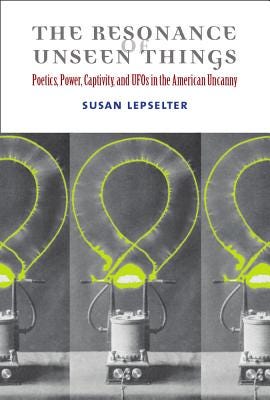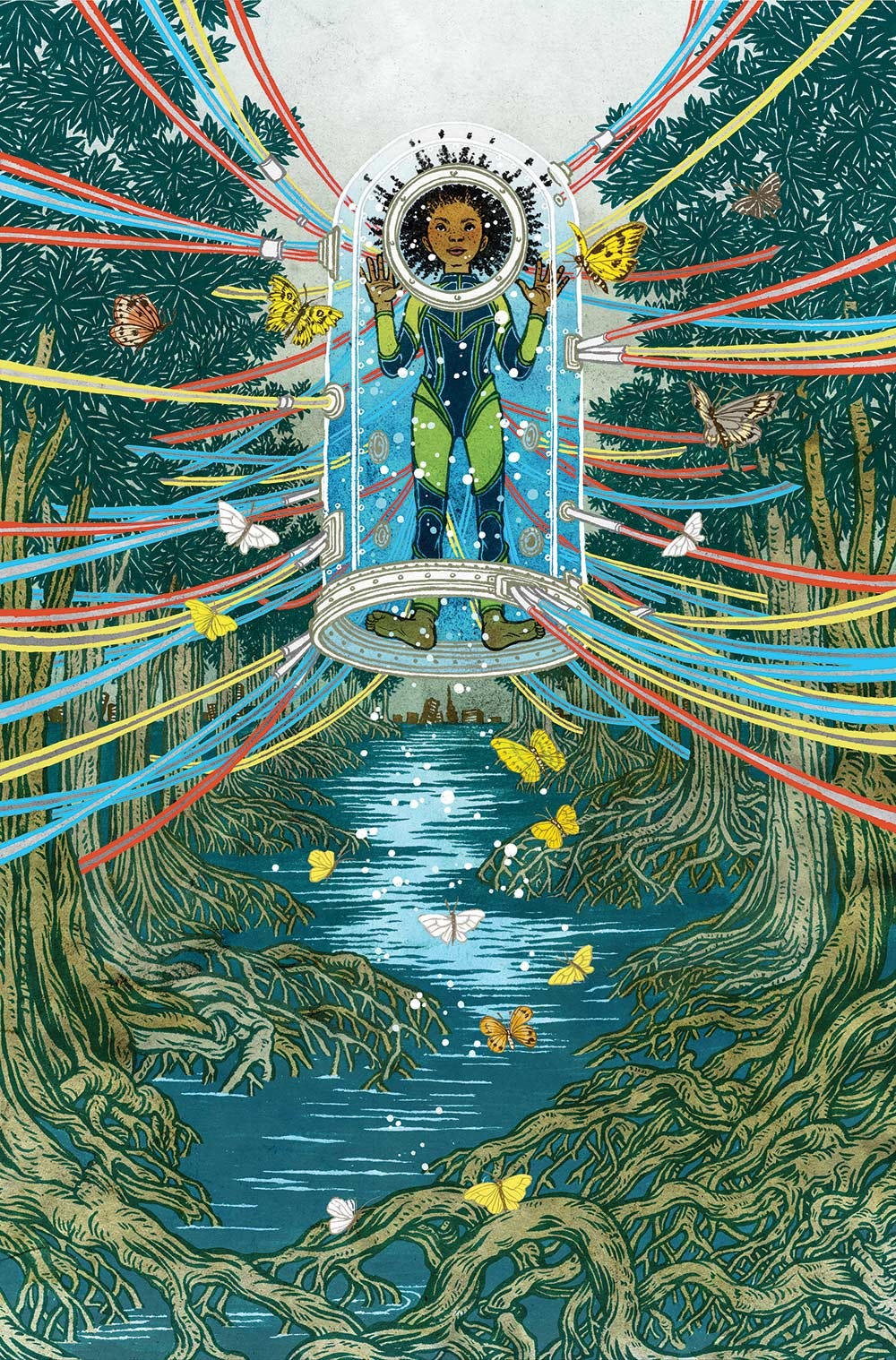029. Science Fiction Reliquary (I)
A professor once described science fiction as something futuristic caught within a particular time and place. To create science fiction is to build new worlds within the ruins of the past.
Hello friends,
A professor once described science fiction as something futuristic caught within a particular time and place. To create science fiction is to build new worlds within the ruins of the past, shaped by historical events, cultural remnants, political struggles, and socioeconomic dynamics of our time.
Over the past year, we’ve all imagined new futures for ourselves. Every day, I see an article that says something like, What will a post-COVID world look like? What is the future of work? What would a world look like without prisons? How would our society change if we cancelled student debt? In the wake of continued horror from mass shootings to police violence to oppressive legislation, those better futures can seem out of reach but now, more than ever, we need to hold them close, to keep doing the work of building and dreaming together.
Studying science fiction academically, especially American SF, means confronting a historical canon of colonialism, racism, ableism, and misogyny under the guise of space exploration and encountering the alien “other.” As an object of pop culture, it’s important to be critical of SF media, to question who is being represented, what stereotypes are being perpetuated. Are we building worlds that challenge our current societal norms? Or are we just upholding and replicating violent power structures?
As you can tell, this is shaping up to be one of my longest letters yet—long enough that I had to break it up into two parts. I’m very excited to share these works and creatives with you from SF communities across America and around the world, and I hope you find inspiration and learn from these vibrant storytellers.
TOUCH
I couldn’t begin this section without talking about one of my favorite sci-fi books ever. Written around the same time as the first Earth Day, The Lathe of Heaven considers the impacts of industrial human interference on the landscape and the potent power of dreaming. Le Guin’s protagonist struggles to control his ability to reshape the fabric of reality, only to end up in the hands of a psychiatrist who seeks to ‘perfect’ their dystopian world plagued by war and pollution. Le Guin’s discussion of inter-human relationships, about environmental calamity, and ways of being within the world are shaped by Taoist thinking, deliberately designed to challenge Western ideals of nature-as-machine and social utilitarianism. This book completely re-shaped the way I think about SF writing, and I could dedicate an entire newsletter to talking about it. Instead, I’ll end with one of my favorite quotes: “We're in the world, not against it.”
One of my goals for this year was to read more graphic novels, since that’s a part of literature I’ve never properly explored. A friend of mine recommended Tillie Walden’s On A Sunbeam. This is such a gorgeous story about found families, queer love, and interstellar adventure. The artwork is gorgeous, with lush graphic colors and one of the loveliest representations of space travel to date. It’s the kind of book you can’t just read about, you have to experience the dazzling artwork and poignant, heart-aching narrative for yourself. You can read the entire comic for free online.
Susan Lepselter’s The Resonance of Unseen Things: Poetics, Power, Captivity, and UFOs in the American Uncanny is a great ethnography of UFO abductees, communities with high rates of sightings, and a look at how conspiracy theories have come to dominate American culture in the wake of economic crises and personal trauma. Lepselter’s analysis, which considers the intersections of race, gender, and class, was really enriching to read as someone who watched a lot of government-conspiracy style sci-fi shows growing up, like The X-Files. Aliens take on a whole new political and sociocultural meaning.
Then there’s Asja Bakic’s Mars. Venturing into the magical and the folkloric, Bakic’s short stories considers female empowerment, bodily autonomy, and dynamics of power in strange, speculative realities. If you’re looking to get into Post-Soviet SF, this collection is a great place to start. It’ll leave you feeling ethereal, feral, and weird (in the best way possible).
I picked up this fun book by Joyce S. Lee about the representation of facial recognition software in cinema. I love how the selection of movies spans over several decades, not only in sci-fi genre films (like 2001: A Space Odyssey) but a whole host of thrillers and blockbuster action films. It’s so fascinating to see how some older films predicted the conundrums of privacy and mass-surveillance we’re dealing with today, and how others managed to completely miss the mark in accuracy. Identified is a cool zine concept and a great primer if you’re interested in studying how technological innovation is depicted in the movies.
I can’t talk about science fiction’s power to create bold new futures without mentioning Kim Stanley Robinson’s Red Mars. Book one of an amazing trilogy, Robinson considers what it would be like to terraform Mars into a kind of second Earth. If you’re more of a fan of hard sci-fi (meaning you value scientific accuracy in the author’s inclusion of imaginary technological innovation), this book, and Robinson’s body of work in general, is perfect for you. Robinson’s writing process consisted of consulting with researchers across different scientific disciplines, including NASA scientists, to explain the process of colonizing the planet. Published in 1992, this book feels prophetic in today’s Mars missions.
LOOK
Ashley Jane Lewis’s creative practice cannot be distilled down into a single description, and that’s what I love about it. An afrofuturist artist with a background in computational media, Lewis’s current medium of choice is rooted in the biological—fermentation processes and slime molds. What I appreciate the most is Lewis’s commitment to education and community-building. Her focus is not only on making work, but how to share skills and come together to create better futures collectively. Lewis’s instinct to question, experiment with, and challenge our relationships to technology and food, and the ethics and social implications of digital networks, presents us with a path forward.
The Metabolist movement merged in Japan in the 1960s and its impacts on design can still be seen (and experienced) today. The Metabolists sought to transform urban spaces through the lens of science fiction, imagining cities floating on water and suspended in the air. As their manifesto notes, “We regard human society as a vital process—a continuous development from atom to nebula. The reason why we use such a biological word, metabolism, is that we believe design and technology should be a denotation of human society.” Emerging from the destruction of WWII, this style, which can be seen in the work of architects Kisho Kurokawa, Kenzo Tange, Arata Isozaki, Fumihiko Maki, and Kiyonori Kikutake, is characterized by cellular, organic modular deigns with an emphasis on utopian functionality.
Based in the UK, Death & Milk’s bold, graphic work merges the cyborg with the mundane. I love how each vignette is full of whimsy, creating a visual language of cyberpunk that is still rooted in the complex emotionality of the human experience. Their representation of tech doesn’t try to be too sleek and sexy. Its overgrown with nature, edges sharpened on film noir, and rooted in a gritty, yet playful realism.
Then there’s Canadian artist, Ashley Mackenzie. They’ve done amazing work for sci-fi and fantasy authors like Veronica Roth and Garth Nix. They take a more abstract approach to conceptual illustrations, and all of their glowing images have this amazing celestial enchantment to them that feels both organic and otherworldly.
Yuko Shimizu’s fantastical works completely explode with color. Coupled with a skillful structure of intricate line-work, your eyes sink into each detailed composition. You can’t help but get sucked into her speculative worlds and fantastical character deisgn. Shimizu has worked on illustrations for SF books and articles, like this piece on speculative journalism and covers for SF comic books, building a career that’s should inspire illustrators everywhere.
Lastly, I thought I’d share artwork from one of the greats: Jean Giraud, also known as Moebius. Working within a surreal kaleidoscopic style, his comic books and concept art has influenced filmmakers over the years, including Hayao Miyazaki, Ridley Scott, and Stan Lee. If you’ve ever seen the concept art for The Fifth Element, Alien, or the Empire Strikes Back, you’re already familiar with his iconic work and legacy.
LISTEN
Whenever want to feel like I’m drifting off into a far-off galaxy while I read, I always put on The Heliocentrics’ song, “Space Time Girl.” It’s a purely instrumental track, and I love how it rolls and grooves, building into a hypnotic delirium. This is the perfect soundtrack for slipping into alternate realities.
Hollow Public Radio is one of my favorite SF audio dramas out there. Each episode is a series of comedic shorts presented through an intergalactic radio station. Teetering between the silly and the downright existential, I’m so moved by the great sound design and brilliant writing. Every episode pulls me right in and always manages to make me laugh. They recently just came back after a long hiatus with a new 3-part series based on a multi-dimensional customer service help line. Check it out!
Electronic music’s link to science fiction aesthetics is nothing new, but I thought I would share the work of one DJ whose mixes always feel downright science-fictional: Josey Rebelle. From the opening track in her Beats in Space mix to her celestial mix for Discwoman, she intertwines samples from political revolutionaries with bubbling, atmospheric melodies, dancing across genres as one might dance through the stars.
If you’re looking for a show that speculates on our current moment, I highly recommend checking out Flash Forward. Each episode considers a possible (or implausible) future. Think: cities built by celebrity brands, being immune to everything, putting polar bears in Antartica, and how North American would change if we gave all stolen land back to Indigenous peoples. This show is a great exercise in imagination. I love how we hear from experts who not only present the answers to these questions, but show us how theses fictional futures may be closer than we think.
The Milk Street Radio podcast recently had food stylist Jance Poon on their show. Poon is not just any kind of film stylist, she’s the mastermind behind some of the grossest food-related special effects in sci-fi and horror film and television. From creating grotesque cannibalistic concoctions for Hannibal to sweet treats for The Shape of Water, it’s so fun to hear how she improvised and experimented with edible arrangements.
LICK
At the end of last summer, I watched Ex Machina for the first time. It’s a simple story: a computer programmer wins a trip to the remote home of his company’s CEO where he encounters a bold experiment in artificial intelligence. This movie is a wild ride from start to finish, and you truly have no sense of what’s going to happen next. It’s a fascinating look at it means to be human, and the ways in which our biases can shape technological innovation, leading us to marginalize and dehumanize others. I’m not sure if I would consider this film to be cyberfeminist in nature, but it’s certainly close.
Ines Alpha is a self-described “3-d makeup creator,” known on platforms like Instagram for her eye-catching science-fictional face filters. Playing with biophilic design and augmented reality, Alpha’s work is not only fun for users to interact with, but helped open up a broader cultural conversations about experiential, digitally-rendered design and its relation to fashion and beauty. Do you consider her work to be makeup? Or sculpture? Or something in between?
Of course, I have to include legendary jazz musician Sun Ra. Dubbed the father of Afrofuturism by many, Ra made his debut in the 1950s with his Arkestra dressed in futuristic Egyptian-style garb. Over the course of his life, he’d record 200 albums and build an amazing mythology as an alien who came to Earth from Saturn. His multi-spiritual, multi-genre work sought to empower and uplift Black Americans in the face of prevalent violence throughout the Jim Crow and Black Power eras. His ideology is best seen through the psychedelic short film, Space is the Place, as he hopes to colonize a new planet away from the racist systems of oppression in America.
I was completely heartbroken when pop musician, SOPHIE, died in a tragic accident back in January. She was an innovator in the PC Music and hyperpop scenes, paving the way for a whole new kind of messy, clanging, alien sound. To honor her memory, I’m including her interview with the AI-powered robot, Sophia, from 2018. It’s so amazing to watch SOPHIE probe at Sophia’s intelligence, to speculate on the future of AI in creative fields and about each of their dreams. SOPHIE truly was the future.
Attack the Block is one of the best sci-fi movies of the 2010s. Starring a pre-Star Wars John Boyega, we follow a bunch of teenagers in a South London housing block as they take on alien invaders. It’s a fun movie with a killer soundtrack, and I appreciate how the film reckons with class and race (something many big-budget SF franchises tend to avoid), challenging the stereotypes at the time of hoodie-wearing teen gangs.
CLICK
Sasha Geffen’s essay on Blade Runner: 2046’s emphasis on motherhood as a way of defining the replicants’ humanity. Geffen gets to the heart of a common problem in SF: defining the “other” in relation (or opposition to) a conformity to white, heterosexual, able-bodied social hegemony. Why should these superhuman cyborgs define themselves through childbirth? How does the film’s concern with bodily reproduction reflect issues of labor exploitation under capitalism? One line stands out: “Rather than constructing value beyond the human, replicants long for the nuclear family structure as soon as they know it’s available to them.”
On the topic of cyborgs, I want to include Danya Glabau’s great essay, “Do Cyborgs Have Politics?” Glabau’s analysis of the inherent politicization of technology is a wonderful reminder that science (and science fiction) can never be completely neutral, disconnected from present socioeconomic concerns. Glabau considers how our relationship to machines shape our identity through Donna Harraway’s “Cyborg Manifesto,” and medical devices which extend disabled folks’ lives. She writes, “These politics revolve around questions of belonging and difference, production and consumption, waste and renewal, inclusion and exclusion.”
What does science-fictional thinking look like IRL? The answer is probably biopunk. This 3-part piece from The New Inquiry looks at DIY labs and the subversive scientists and artists who want to experiment with biological engineering as a way to challenge our modern surveillance system. From at-home gene testing kits to a project that seeks to create open-source hormone therapy for trans folks, the body can become the site of technological liberation, although the specter of biopolitical oppression lingers.
Rio Cortez’s “UFO, For Instance,” recounts a peculiar sighting. Inspired by her evangelical grandmother’s story of an encounter with a mysterious flashing vehicle out in the desert, Cortez’s gorgeous lyricism embraces the unexplainable. I especially love the lines: “when in the clearing you are certain / you are not lonelier / but there is a lifting in you / where other knowing rises too.” The image of a UFO tractor beam comes to mind, raising you up into the liminal spaces between truth and belief.
Thanks for taking the time to read! Feel free to share this little project of mine with your friends, lovers, and enemies. If you like what I do, you can help feed my leopard gecko through Ko-Fi or check out my website. You can find a list of books by the people I mentioned on Bookshop (I get a small commission through this and any affiliate links in this letter).
Until next time,
Ellie




















